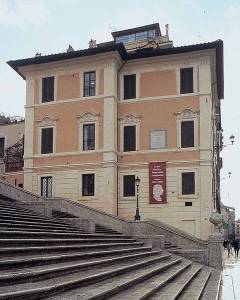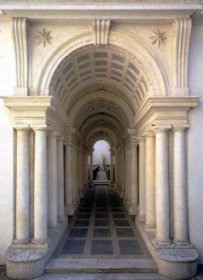|
|
| |
ITALY
ROME MUSEUMS
Capitoline Museums The Capitoline Museums (Italian Musei Capitolini) are a group of art and archeological museums in Piazza del Campidoglio, on top of the Capitoline Hill in Rome, Italy. The museums are contained in three palazzi surrounding a central trapezoidal piazza in a plan conceived by Michelangelo Buonarroti in 1536 and executed over a period of over 400 years. The museums' collection has grown to include a large number of ancient Roman statues, inscriptions, and other artifacts; a collection of medieval and Renaissance art; and collections of jewels, coins, and other items. In the Palazzo dei Conservatori collections of ancient sculptures can be found, mostly Roman but also Greek and Egyptian. The Conservator's Apartment is distinguished by elaborate interior decorations, including frescoes, stuccos, tapestries, and carved ceilings and doors. The Capitoline Coin Cabinet, containing collections of coins, medals, jewels, and jewelry, and is located in the attached Palazzo Caffarelli-Clementino. Statues, inscriptions, sarcophagi, busts, mosaics, and other ancient Roman artifacts occupy two floors of the Palazzo Nuovo.
For more information and enquiries please contact Musei Capitolini, Piazza del Campidoglio, 1 - 00186 ROMA,
Tel.: 060608 every day 9.00-21.00, E-mail: info.museicapitolini@comune.roma.it
 The Palazzo dei Conservatori is one of the three main buildings of the Capitoline Museums Copyright © Radomil
Doria Pamphilj Gallery The Doria Pamphilj Gallery is a large art collection housed in the Palazzo Doria Pamphilj in Rome, Italy. It is situated between the Via del Corso and Via della Gatta. The principal entrance is on the Via del Corso (until recently entrance to the gallery was from the Piazza del Collegio Romano). Like the palace, it is still privately owned by the princely Roman family Doria Pamphilj. The large collection of paintings, furniture and statuary has been assembled since the 16th century by the Doria, Pamphilj, Landi and Aldobrandini families. The collection includes paintings and furnishings from the Innocent X's Palazzo Pamphilj (in Piazza Navona). The Palazzo has grown over the centuries; it is likely the largest in Rome still in private ownership. The main collection is displayed in state rooms, including the chapel, complete with the mummified corpse of the family saint. However, the bulk is displayed in a series of four gilded and painted galleries surrounding a courtyard. An extensive suite of further rooms have now been converted to permanent well-lit galleries, containing the more medieval and Byzantine art in the collection.
For more information and enquiries please contact Entrance Via del Corso, 305 - Rome,
Tel: 2006 / 6797323, E-mail: arti.rm@doriapamphilj.it
 The courtyard of the four sided gallery housing the collection's principal paintings
Keats-Shelley Memorial HouseyThe Keats-Shelley Memorial House in Rome is a museum commemorating the lives and works of the Romantic poets John Keats and Percy Bysshe Shelley. The museum houses one of the world's most extensive collections of memorabilia, letters, manuscripts, and paintings relating to Keats and Shelley, as well as Byron, Wordsworth, Robert Browning, Elizabeth Barrett Browning, Oscar Wilde, and others. It is located on the second floor of the building situated just to the south of the base of the Spanish Steps and east of the Piazza di Spagna.
For more information and enquiries please contact Piazza di Spagna 26,
00187, Rome, Tel: (+39) 06 678 4235
Italy E-mail: info@keats-shelley-house.org
 View of the Keats-Shelley House from the Spanish Steps in Rome
Vatican Museums The Vatican Museums, in Viale Vaticano in Rome, inside the Vatican City, are among the greatest museums in the world, since they display works from the immense collection built up by the Roman Catholic Church throughout the centuries. The Vatican Museums were visited by 4,310,083 people in the year 2007.
 A spiral staircase inside one of the Vatican Museums Photo by Andreas Tille
Pinacoteca Art GalleryThe museum has many famous paintings such as Giotto's Stefaneschi Triptych, Raphael's Madonna of Foligno and Transfiguration, Leonardo da Vinci's St. Jerome in the Wilderness, Caravaggio's Entombment, and Perugino's Madonna and Child with Saints. The Collection of Modern Religious Art houses paintings and sculptures from artists like Carlo Carrà and Giorgio de Chirico.
Museo Pio-ClementinoPope Clement XIV founded the Pio-Clementino Vatican museum in 1771, and originally it contained the Renaissance and antique works. The museum and collection were enlarged by Clement's successor Pius VI. Today, the museum houses works of Greek and Roman sculpture. There are 54 galleries, or "salas" in total, with the Sistine Chapel, notably, being the very last sala within the Museum - visitors need to proceed through the other 53 salas before earning their reward with access to the Sistine. Some of the more notable galleries include:
Greek Cross Gallery: with the porphyri sarcophagi of Constance and Saint Helen, daughter and mother of Constantine the Great.
Sala Rotonda: shaped like a miniature Pantheon, the room has impressive ancient mosaics on the floors, and ancient statues lining the perimeter, including a gilded bronze statue of Hercules.
Gallery of Statues: as its name implies, holds various important statues, including Sleeping Ariadne and the bust of Menander. It also contains the Barberini Candelabra.
Cabinet of Masks: The name comes from the mosaic on the floor of the gallery, found in Villa Adriana, which shows ancient theater masks. Along the walls, several famous statues are shown including the Three Graces.
Sala delle Muse: Houses the statue group of Apollo and the nine muses as well as statues by important ancient Greek sculptors.
Sala degli Animali: So named because of the many ancient statues of animals.
 The New Wing, Braccio Nuovo built by Raphael Stern. Photo by Jesús Moreno The museum consists of a large arched gallery in which sides are exhibited several statues, sarcophaguses and friezes. The New Wing, Braccio Nuovo built by Raphael Stern, houses important statues like The Prima Porta Augustus and The River Nile. Galeria Lapidaria is another part of Chiaramonti museum, with more than 3,000 stone tablets and inscriptions, which is the world's greatest collection of its kind.
Museo Gregoriano EtruscoThis museum has eight galleries and houses important Etruscan pieces, coming from archaeological excavations. The pieces include: vases, sarcophagus, bronzes and the Guglielmi Collection.
Museo EgizianoThis museum houses a grand collection of Ancient Egyptian material. Such material includes papyruses, the Grassi Collection, animal mummies, and the famous Book of the Dead.
For more information and enquiries regarding the Vatican Museums please contact Viale Vaticano, 00165, Rome, Tel: 0039 06 69884676 - 0039 06 69883145 E-mail support: help.musei@scv.va
Palazzo Spada The Palazzo Spada is a palace in Rome that houses a grand art collection, the Galleria Spada. The collection was originally assembled by Cardinal Bernardino Spada in the 17th century. The palace is located in the rione Regola, at Piazza Capo di Ferro, 13, with a garden facing the Tiber, very close to the Palazzo Farnese. Francesco Borromini created the masterpiece of trompe-l'oeil false perspective in the arcaded courtyard, in which diminishing rows of columns and a rising floor create the optical illusion of a gallery 37 meters long (it is 8 meters) with a lifesize sculpture in daylight beyond: the sculpture is 60 cm high.
 Trompe-l'oeil mural and gallery by Francesco Borromini. The hallway is much shorter, and the sculpture much smaller, than they appear.
The Mannerist stucco sculptural decor of the palazzo's front and its courtyard façades feature sculptures crowded into niches and fruit and flower swags, grotesches and vignettes of symbolic devices (impresi) in bas-relief among the small framed windows of a mezzanine, the richest cinquecento façades in Rome.
 Facade of the Palazzo Spada
Cardinal Spada's collection, which includes four galleries of 16th and 17th-century paintings by Andrea del Sarto, Guido Reni, Titian, Jan Brueghel the Elder, Guercino, Rubens, Dürer, Caravaggio, Domenichino, the Carracci, Salvator Rosa, Parmigianino, Francesco Solimena, Michelangelo Cerquozzi, Pietro Testa, Giambattista Gaulli, and Orazio and Artemisia Gentileschi, has the additional interest of being hung in the 17th-century manner, frame-to-frame, with smaller pictures "skied" above larger ones.
National Museum of Rome (Museo Nazionale Romano)The National Museum of Rome is a set of museums in Rome, Italy, split among various branches across the city. Its base was established in the 16th century cloister built by Michelangelo off the baths of Diocletian, still its main base.
Crypta BalbiIn 1981, digging on a derelict city-centre site in the Campus Martius between the churches of Santa Caterina dei Funari and San Stanislao dei Polacchi, Daniel Manacorda and his team discovered the colonnaded quadriporticus of the Theatre of Lucius Cornelius Balbus, the nearby statio annonae and evidence of later, medieval occupation of the site. These are presented in this branch, inaugurated in 2001, which houses the archaeological remains and finds from that dig.
As well as new material from the excavations, objects in this museum come from:
the collections of the former Kircherian Museum
the Gorga and Betti collections
numismatic material from the Gnecchi collections and the collection of Victor Emmanuel III of Savoy,
collections from the Roman Forum,
Museum of the Palazzo Venezia
the Capitoline Museums
the communal Antiquarium of Rome
frescoes removed in 1960 from the church of Santa Maria in Via Lata
Palazzo AltempsThe Palazzo Altemps is located in the modern rione Ponte, part of the Campus Martius, a part of Ancient Rome that was developed beginning under the emperor Augustus. It is located directly north of the Piazza Navona.It houses the museum's displays on the history of collecting (sculptures from Renaissance collections such as the Boncompagni-Ludovisi and Mattei collections, including the Ludovisi Ares and the Suicide of a Gaul (from the same Pergamon group as the Dying Gaul) and the 'Egyptian Collection (sculptures of eastern deities). The palace also includes the historic private theatre, at present used to house temporary exhibitions, and the church of Sant' Aniceto.
For more information regarding the National Museums of Rome please contact Superintendence for Archaeological Heritage of Rome, Piazza Santa Maria Nova, 53 - 00186, Rome, Telephone the switchboard: (+39) 06480201, E-mail: ssba-rm@beniculturali.it
 Exterior view of the Palazzo Altemps Photo by Lalupa
|
|
|
|
|